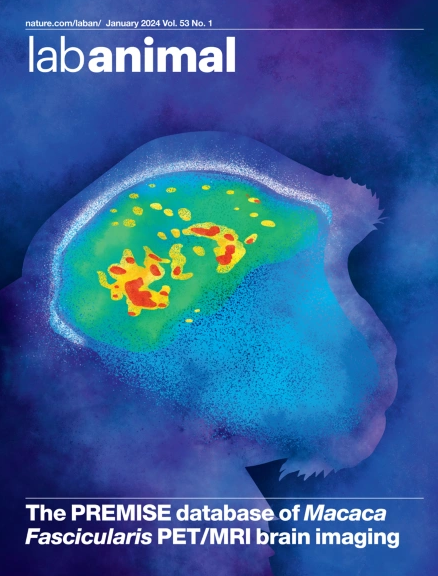改善急性淋巴细胞白血病小鼠原位异种移植模型的疼痛管理。
IF 3.9
3区 农林科学
Q1 VETERINARY SCIENCES
引用次数: 0
摘要
尽管正在进行的研究,现实的急性淋巴细胞白血病(ALL)的体外模型,可以模拟复杂的病理仍然不可用,强调需要持续的动物为基础的研究。作为3R原则的一部分,动物实验的不断改进是强制性的。因此,回顾使用的镇痛药的有效性是必要的动物模型特定细化。在这里,我们评估了在ALL小鼠模型中,我们研究所以前使用的甲胺唑和曲马多哪个更适合作为按需镇痛。静脉注射人前体ALL细胞系RS4诱导小鼠原位异种移植模型;11或SEM进入免疫缺陷雄性和雌性NSG小鼠。每天对小鼠称重并检查其基本行为和幸福感,同时每周监测详细的福利参数,如挖洞行为、筑巢活动、肛周温度、液体摄入量、粪便皮质酮代谢物、小鼠表情量表和肿瘤细胞增殖。在白血病进展时,当观察到疼痛或不适的迹象时,通过饮用水给予安咪唑(3mg /ml)或曲马多(1mg /ml)进行镇痛治疗,并每天评估详细的福利参数。在治疗开始后,服用安咪唑或曲马多的小鼠体重、液体摄入量和其他福利参数继续下降,这表明这两种药物都不足以完全抵消晚期ALL的影响。将这些数据与相对严重程度评估算法相结合,发现在减轻疾病的有害影响方面,metamizole治疗似乎不如曲马多有效。因此,在未来的研究中,阿片类药物曲马多应该取代安美唑作为血液异种移植模型的首选镇痛化合物,以改善动物福利。本文章由计算机程序翻译,如有差异,请以英文原文为准。
Improving pain management for murine orthotopic xenograft models of acute lymphoblastic leukemia.
Despite ongoing research, realistic in vitro models for acute lymphoblastic leukemia (ALL) that can mimic the complex pathology are still not available, highlighting the need for continuous animal-based investigation. As part of the 3R principles, constant refinement of animal experiments is mandatory. Therefore, reviewing the effectiveness of used analgesics is essential for animal model-specific refinement. Here we evaluate whether metamizole-previously used in our institute-or tramadol is more suitable as on-demand analgesia in mouse models of ALL. The murine orthotopic xenograft models were induced by intravenous injection of either the human precursor ALL cell lines RS4;11 or SEM into immune-deficient male and female NSG mice. Mice were weighed and checked daily for basic behavior and well-being, while detailed welfare parameters, such as burrowing behavior, nesting activity, perianal temperature, liquid intake, fecal corticosterone metabolites, mouse grimace scale and tumor cell proliferation were monitored weekly. Upon leukemic progression, when signs of pain or discomfort were observed, metamizole (3 mg/ml) or tramadol (1 mg/ml) was administered via drinking water for analgesic treatment, and detailed welfare parameters were assessed daily. Following the initiation of treatment, mice receiving either metamizole or tramadol continued to show a decline in body weight, liquid intake and other welfare parameters, suggesting that neither drug was sufficient to fully counteract the effects of late-stage ALL. Combining the data with the relative severity assessment algorithm revealed that metamizole treatment appeared less effective than tramadol in mitigating the detrimental effects of the disease. Therefore, the opioid tramadol should replace metamizole as the analgesic compound of choice for hematological xenograft models to improve animal welfare in future studies.
求助全文
通过发布文献求助,成功后即可免费获取论文全文。
去求助
来源期刊

Lab Animal
农林科学-兽医学
CiteScore
0.60
自引率
2.90%
发文量
181
审稿时长
>36 weeks
期刊介绍:
LabAnimal is a Nature Research journal dedicated to in vivo science and technology that improves our basic understanding and use of model organisms of human health and disease. In addition to basic research, methods and technologies, LabAnimal also covers important news, business and regulatory matters that impact the development and application of model organisms for preclinical research.
LabAnimal's focus is on innovative in vivo methods, research and technology covering a wide range of model organisms. Our broad scope ensures that the work we publish reaches the widest possible audience. LabAnimal provides a rigorous and fair peer review of manuscripts, high standards for copyediting and production, and efficient publication.
 求助内容:
求助内容: 应助结果提醒方式:
应助结果提醒方式:


